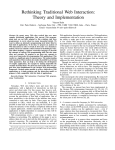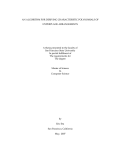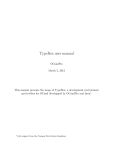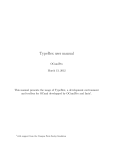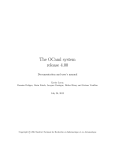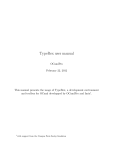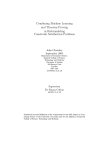Download Alg User Manual
Transcript
Alg User Manual Aleˇs Bizjak∗ Andrej Bauer† June 22, 2014 Contents 1 Introduction 2 2 Copyright and License 2 3 Installation 3.1 Downloading alg . . . . . . . . . . . 3.2 Installation for Linux and MacOS . . 3.2.1 Prerequisites . . . . . . . . . 3.2.2 Compilation and installation 3.2.3 Compiling the manual . . . . 3.2.4 Compiling to bytecode . . . . 3.2.5 Installation without menhir . 3.2.6 Installation without Make . . 3.3 Installation for Microsoft Windows . . . . . . . . . . . . . . . . . . . . . . . . . . . . . . . . . . . . . . . . . . . . . . . . . . . . . . . . . . . . . . . . . . . . . . . . . . . . . . . . . . . . . . . . . . . . . . . . . . . . . . . . . . . . . . . . . . . . . . . . . . . . . . . . . . . . . . . . . . . . . . . . . . . . . . . . . . . . . . . . . . . . . . . . . . . . . . . . . . . . . . . . . . . . . . . . . . . . . . . . . . . . . . . . . . . . . . . . . . . . . . . . . . . . . . . . . . . . . . . . . . . . . . . . . . . . . . . . . . . . . . . . . . . . . . . . . . . . . . . . . . . . . . . . . 3 3 3 3 3 4 4 4 4 4 4 Input 4.1 Comments . . . . . . . . . . . . . . . . 4.2 General syntactic rules . . . . . . . . . 4.3 The Theory keyword . . . . . . . . . . 4.4 Declaration of operations and relations 4.5 Axioms . . . . . . . . . . . . . . . . . . . . . . . . . . . . . . . . . . . . . . . . . . . . . . . . . . . . . . . . . . . . . . . . . . . . . . . . . . . . . . . . . . . . . . . . . . . . . . . . . . . . . . . . . . . . . . . . . . . . . . . . . . . . . . . . . . . . . . . . . . . . . . . . . . . . . . . . . . . . . . . . . . . . . . . . . . . . 5 5 5 5 5 6 5 Output 5.1 Description of the output . . . . . . . . . . . 5.2 Available output formats . . . . . . . . . . . 5.3 Redirection of output to a file . . . . . . . . . 5.4 Output in JSON format for futher processing . . . . . . . . . . . . . . . . . . . . . . . . . . . . . . . . . . . . . . . . . . . . . . . . . . . . . . . . . . . . . . . . . . . . . . . . . . . . . . . . . . . . . . . . . . . . . . . . . . . . . . . . . . . . 7 7 7 7 8 6 Command-line Options 8 7 How to use alg efficiently 7.1 The default algorithm . . . . . . . . . . . . . . . . . . . . . . . . . . . . . . . . . . . . . . . . 7.2 The alternative algorithm . . . . . . . . . . . . . . . . . . . . . . . . . . . . . . . . . . . . . . 9 9 10 8 Support and bug reports 10 ∗ [email protected], Faculty of Mathematics and Physics, University of Ljubljana Faculty of Mathematics and Physics, University of Ljubljana † [email protected], 1 1 Introduction Alg is a program for enumeration of finite models of single-sorted first-order theories. Such a theory is given by a signature (a list of constants, operations and relations) and axioms expressed in first-order logic. Examples of first-order theories include groups, lattices, rings, fields, posets, graphs, and many others. Alg can do the following: • list or count all non-isomorphic models of a given theory, • list or count all non-isomorphic indecomposable1 models of a given theory. Currently alg has the following limitations: • the theory must be single-sorted, • only unary and binary operations are accepted, • only (unary) predicates and binary relations are accepted, • it is assumed that constants denote pairwise distinct elements. This manual describes how to install and use alg. For a quick start you need Ocaml 3.11 or newer and the menhir parser generator. Compile alg with make and run ./ alg . native -- size 8 theories / un it a l_ c om mu t at iv e _r i ng . th For usage information type ./alg.native -help and for examples of theories see the theories subdirectory. Alg is released under the open source simplified BSD License, as detailed in the next section. 2 Copyright and License c 2010, Aleˇs Bizjak and Andrej Bauer Copyright All rights reserved. Redistribution and use in source and binary forms, with or without modification, are permitted provided that the following conditions are met: • Redistributions of source code must retain the above copyright notice, this list of conditions and the following disclaimer. • Redistributions in binary form must reproduce the above copyright notice, this list of conditions and the following disclaimer in the documentation and/or other materials provided with the distribution. This software is provided by the copyright holders and contributors “as is” and any express or implied warranties, including, but not limited to, the implied warranties of merchantability and fitness for a particular purpose are disclaimed. In no event shall the copyright holder or contributors be liable for any direct, indirect, incidental, special, exemplary, or consequential damages (including, but not limited to, procurement of substitute goods or services; loss of use, data, or profits; or business interruption) however caused and on any theory of liability, whether in contract, strict liability, or tort (including negligence or otherwise) arising in any way out of the use of this software, even if advised of the possibility of such damage. 1A model is indecomposable if it cannot be written as a non-trivial product of two smaller models. 2 3 Installation 3.1 Downloading alg Alg is available at http://hg.andrej.com/alg/. You have three options: 1. download the ZIP file with source code from http://hg.andrej.com/alg/archive/tip.zip 2. clone the repository with the Mercurial revision control system: hg clone http :// hg . andrej . com / alg / 3. download a precompiled executable for your architecture, as described at http://math.andrej.com/alg/ if one is available. 3.2 Installation for Linux and MacOS 3.2.1 Prerequisites To compile alg you need Ocaml 3.11 or newer. It is also highly desirable that you have the menhir parser generator and the Make utility. See sections 3.2.6 and 3.2.5 on how to compile without these. You can get Ocaml and menhir in several ways: 1. On Ubuntu, install the packages ocaml and menhir: sudo apt - get install ocaml menhir Similar solutions are available on other Linux distributions. 2. On MacOS the easiest way to install Ocaml and menhir is with the macports utility: sudo port install ocaml sudo port install caml - menhir 3. If you have GODI installed then you already have Ocaml. Install menhir with the godi console command, if you do not have it yet. 4. Ocaml is also available from http://caml.inria.fr/ and menhir from http://pauillac.inria.fr/~fpottier/menhir/ 3.2.2 Compilation and installation To compile alg, type make native at the command line. If all goes well ocamlbuild will generate a subdirectory build and in it the alg.native executable. It will also create a link to build/alg.native from the top directory. To test alg type ./ alg . native -- count -- size 8 theories / group . th 3 It should tell you within seconds that there are 5 groups of size 8. We provided only a very rudimentary installation procedure for alg. First edit the INSTALL DIR setting in Makefile to set the directory in which alg should be installed, then run sudo make install This will simply copy build/alg.native to $(INSTALL DIR)/alg. You may also wish to stash the theories subdirectory somewhere for future reference. 3.2.3 Compiling the manual You do not have to compile the manual because it is included in doc/manual.pdf. Nevertheless, you can recompile it by typing make doc or directly by LATEX-ing doc/manual.tex. 3.2.4 Compiling to bytecode If your version of Ocaml does not compile to native code you can try compiling to bytecode with make byte This will generate a (significantly slower) alg.byte executable. 3.2.5 Installation without menhir If you do not have menhir you can try the following trick: • move the files lexer.mll and parser.mly out of the way into some other folder, • copy the files nomenhir/lexer.ml and nomenhir/parser.ml to where lexer.mll and parser.mly used to be, • compile with make. In other words: $ mv lexer . mll parser . mly nomenhir $ cp nomenhir / lexer . ml nomenhir / parserl . ml . $ make 3.2.6 Installation without Make If you do not have the Make utility (how can that be?) you can compile alg directly with ocamlbuild: ocamlbuild -use - menhir alg . native To install alg just copy build/alg.native to /usr/local/bin/alg or some other reasonable place. 3.3 Installation for Microsoft Windows With Ocaml 3.11, menhir and the MinGW or cygwin suite installed compilation should be essentially the same as for Linux and MacOS, as described in section 3.2. Also see sections 3.2.5 and 3.2.6 on how to compile without menhir and Make. Note that a Windows precompiled executable may be available at http://math.andrej.com/alg. 4 4 Input An alg input file has extension .th and it describes an a first-order theory. The syntax vaguely follows the syntax of the Coq proof assistant. A typical input file might look like this: Theory Group . Constant 1. Unary inv . Binary *. Axiom unit_left : 1 * x = x . Axiom unit_right : x * 1 = x . Axiom inverse_left : x * inv ( x ) = 1. Axiom inverse_right : inv ( x ) * x = 1. Axiom associativity : ( x * y ) * z = x * ( y * z ). The file starts with an optional Theory declaration which names the theory, then we have declarations of constants, unary and binary operations, predicates and binary relations (none in the above example), and after that there are the axioms. The precise syntax rules are as follows. 4.1 Comments Comments are written as in Python, i.e., a comment begins with the # symbol and includes everything up to the end of line. 4.2 General syntactic rules An alg input file consists of a sequence of declarations (Theory, Constant, Unary, Binary, Predicate, Relation) and axioms (Axiom, Theorem). Each declaration and axiom is terminated with a period. 4.3 The Theory keyword You may give a name to your theory with the declaration Theory theory_name . at the beginning of the input file, possibly preceded by comments and whitespace. The theory name consists of letters, numbers, and the underscore. If you do not provide a theory name, alg will deduce one from the file name. 4.4 Declaration of operations and relations The declarations Constant c1 c2 . . . ck . Unary u1 u2 . . . um . Binary b1 b2 . . . bn . Predicate p1 p2 . . . pl . Relation r1 r2 . . . rj . are used to declare constants, unary and binary operations, predicates, and binary relations, respectively. You may declare several constants or operations with a single declaration, or one at a time. You may mix declarations and axioms, although it is probably a good idea to declare the constants and operations first. The keywords Constants, Predicates and Relations are synonyms for their singular counterparts. A constant may be any string of letters, digits and the underscore character. In particular, a constant may consist just of digits, for example 0 or 1. Predicates, relations, unary and binary operations may be strings of letters, digits and the underscore character. For example, if we declare 5 Unary inv . Binary mult . then we can write expressions like mult(x, inv(y)). It is even possible to declare operations whose names are strings of digits, for example: Unary 3 ten . Binary +. Axiom : 3(3( x )) + x = ten ( x ). Alternatively, we can use infix and prefix operators. These follow the Ocaml rules for infix and prefix notation. An operator is a string of symbols ! $ % & * + - / \ : < = > ? @ \^ | ~ where: • a prefix operator is one that starts with ?, ! or ~. It can be used as a unary operation. • infix operators can be used as binary operations and have four levels of precedence, listed from lowest to highest: – – – – – left-associative operators starting with =, <, >, |, &, $ right-associative operators starting with @ and ^ left-associative operators starting with +, -, and \ left-associative operators starting with *, /, and % right-associative operators starting with **. An operator ◦ is left-associative if x ◦ y ◦ z is understood as (x ◦ y) ◦ z, and right-associative if x ◦ y ◦ z is understood as x ◦ (y ◦ z). If you look at the above list again, you will notice that operators have the expected precedence and associativity. However, if you are unsure about precedence, it is best to use a couple of extra parentheses. 4.5 Axioms An axiom has the form Axiom [ name ] : < formula > . or Theorem [ name ] : < formula > . There is no difference between an axiom and a theorem as far as alg is concerned. A good convention is to use Axiom for the actual axioms and Theorem for statements that are consequences of axioms and are worth including in the theory because they make alg run faster, see Section 7. The optional [name] is a string of of letters, digits and the underscore characters. Alg has no use for names, they are there for the user. The <formula> is a first-order formula built from the following logical operations, listed in order of increasing precedence: ∀x . φ ∃x . φ φ⇔ψ φ⇒ψ φ∨ψ φ∧ψ ¬φ s=t s 6= t > and ⊥ is written as is written as is written as is written as is written as is written as is written as is written as is written as are written as forall x, φ, exists x, φ, φ <-> ψ or φ <=> ψ, φ -> ψ or φ => ψ, φ \/ ψ or φ or ψ, φ /\ ψ or φ and ψ, not φ, s = t, s <> t or s != t, True and False, respectively. 6 An iterated quantification ∀x1 . ∀x2 . · · · ∀xn . φ may be written as forall x1 x2 . . . xn , φ. and similarly for ∃. Axioms may contain free variables. Thus we can write just Axiom : x + y = y + x . instead of Axiom : forall x y , x + y = y + x . 5 Output 5.1 Description of the output The output of alg is meant to be self-explanatory. Nevertheless, here is what the output consists of: Title: the name of the theory. Theory: the input file, which can be suppressed with --no-source command-line option. Models: a list of the models found. This can be suppressed with the --count command-line option. Each model has a name theory name n m where n is the model size and m is the model sequence number. If a model can be decomposed, a decomposition into indecomposable factors is given.2 Tables of all the operations and relations are displayed. Counts: a table showing how many models of each size were found. If more than three sizes were considered, alg also provides a URL to query the counts at http://oeis.org/, the On-Line Encyclopedia of Integer Sequences. 5.2 Available output formats Alg supports several output formats. The default is plain text and it is sent to the screen. You can choose one of the following formats with the --format command-line option: • text: the default format is plain text. Actually, it is not entirely plain, as it is also valid Markdown.3 • html: Hypertext Markup Language, used for web pages. • latex: LATEX format, suitable for showing multiplication tables in published papers. • json: the JSON format, suitable for futher processing, as explained in Section 5.4. If you specify an output file with the --output option but no --format, alg guesses the correct format from the output filename extension. 5.3 Redirection of output to a file By default alg prints results on the standard output. You may redirect the output to a file with the --output option. If you use --output without --format, alg tries to guess the output format from the filename extension. 2 Please note that in general such a decomposition is not unique. to Wikipedia, Markdown is a lightweight markup language, originally created by John Gruber and Aaron Swartz to help maximum readability and ”publishability” of both its input and output forms. 3 According 7 5.4 Output in JSON format for futher processing For further processing of output use the JSON output format by specifying --format json or output to a file with the .json extension. The JSON output has one of two forms, depending on whether the --count option is used. Without it, the output is a list [" theory_name " , M1 , ... , Mn ] where M1 , . . . , Mn are the models found. Each model Mi is given as a dictionary which maps constants, unary operations and binary operations, predicates and relations to the corresponding integers, tables and matrices. For example, the only commutative ring of size 6 with unit is presented as { "0" "1" "~" "+" [ : 0, : 4, : [0 , 2 , 1 , 3 , 5 , 4] , : [0 , [1 , [2 , [3 , [4 , [5 , ], "*" : [ [0 , [0 , [0 , [0 , [0 , [0 , ] 1, 2, 0, 4, 5, 3, 2, 0, 1, 5, 3, 4, 3, 4, 5, 0, 1, 2, 4, 5, 3, 1, 2, 0, 5] , 3] , 4] , 2] , 0] , 1] 0, 1, 2, 0, 1, 2, 0, 2, 1, 0, 2, 1, 0, 0, 0, 3, 3, 3, 0, 1, 2, 3, 4, 5, 0] , 2] , 1] , 3] , 5] , 4] } The underlying set of the ring is {0, 1, 2, 3, 4, 5}, the neutral elements for addition and multiplication are 0 and 4, respectively, and the operations are given as lookup tables, for example, ~ 1 = 2 and 4 * 3 = 3. The --count option gives JSON output [" theory_name " , [[i1 ,k1 ] , ... , [in ,kn ]]] which is read as saying that there are kj models of size ij . In Python you can import JSON data from a file mystuff.json like this: import json with open ( ’ mystuff . json ’ , ’r ’) as f : mystuff = json . load ( f ) In Mathematica just use the Import["mystuff.json "] command. 6 Command-line Options Alg is used as alg -- size < sizes > [ options ] < theory . th > where theory.th is the input file, and the options are: 8 --size <sizes> A comma-separated list of sizes that alg should consider. You can also specify a size interval of the form m-n . For example, 1,2,5-8 would mean that we consider sizes 1, 2, 5, 6, 7, 8. --count Do not print out the models, just report the counts. --format <format> Output in the given format. Supported formats are text, html, latex, and json. --indecomposable Output only indecomposable models, i.e., those that are not products of smaller models. --axiom Add an extra axiom to the theory. Use the option several times to add several axioms. Note that on a command-line the axiom should be enclosed in quotes. --no-products Do not try to generate models as products of smaller models. Use this option if you know that a model cannot be a product of smaller ones. For example, a field can never be a product of two fields. The option is assumed if the theory contains predicates or relations. If all of your axioms are equations, then you should not use this option. --no-source Do not include the theory in the output. --output <filename> Output to the given file rather than to screen. --paranoid Perform additional checks to verify that the models really satisfy the axioms. Use this option if you think there is a bug in alg. --sat Use the alternative algorithm based on satisfying the axioms rather than intelligent filling-in of multiplication tables. It works well with theories that have predicates and relations. For theories with unary and binary operations the standard algorithm typically performs better. --version Print out version information and exit. --help Print help. 7 How to use alg efficiently You should always keep in mind the fact that alg performs a brute force search with a few optimizations. In 2 the worst case its running time is doubly exponential in the size of the models because there are nn tables for a binary operation on a set of size n. Alg contains two diffrent algorithms, the default and the alternative one. As a rule of thumb you should use the default algorithm, unless the signature of your theory consists mostly of predicates and relations. In any case, since the performance is not easily predicted, you should try both algorithms and experiment by rewriting the theory in various equivalent ways. 7.1 The default algorithm The default alg algorithm is optimized for equational theories, i.e., those whose axioms are equations (semigroups, monoids, groups, rings, lattices, etc., but not integral domains and fields). Alg takes advantage of commutativity, associativity and idempotent laws, and to a smaller extent of other kinds of equational laws, such as absorption and distributivity. Alg performs few optimizations based on non-equational axioms. Thus you should try to reduce their number. Furthermore, in non-equational axioms the quantifiers should always be pushed inside as much as possible. For example, instead of Axiom : forall x , exists y , x <> 0 -> x * y = 1. you should write Axiom : forall x , x <> 0 -> exists y , x * y = 1. 9 The best kind of axioms are those that allow alg to immediately fill in a whole column or row. Typically these are axioms about neutral elements, such as 1 · x = x and 0 + x = x. As a rule of thumb, every such axiom will increase the maximum manageable size by one. In general alg performs better if it is given more axioms and theorems, because each additional statement cuts down the possibilities. Thus you should include theorems which already follow from other axioms. For example: • state both 1 · x = x and x · 1 = x, even if one of them follows from the other, • more generally, state all versions of a symmetric equation, even if they all follow from one of them, • state laws like 0 · x = 0 (and also x · 0 = x), even if they follow from other axioms. You should declare as many constants and as few operations as possible. A typical example is the theory of lattices. For finite structures the following are equivalent theories: • a lattice with operations ∧, ∨, • a bounded lattice with operations ∧, ∨ and constants 0, 1, • a ∨-semilattice with operation ∨ and constant 0, • a bounded ∨-semilattice with operation ∨ and constants 0, 1. The best choice is the last one because it has just fewest operation and most constants. Indeed, figuring out that there are 53 lattices of size 7 takes 250 times longer with the theory of a lattice than with the theory of a bounded ∨-semilattice. Lastly, we should mention that alg generates tables in the order in which the operations are declared. Sometimes it is much easier to generate tables for one operation than another, so you should experiment by switching the order of declarations. For example, the theory of a ring works much faster if addition + is declared before multiplication ×. 7.2 The alternative algorithm The alternative algorithm transforms the given axioms into constraints that need to be satisfied. It then solves the constraints in all possible ways by intelligent backtracking. The general rules for efficient use of the alternative algorithm are the same as those for the default one. It turns out that the alternative algorithm generally performs worse than the default one when the theory consists mostly of operations. However, the alternative algorithm usually outperforms the default one for theories which constist mostly of relations. 8 Support and bug reports Please send bug reports and whishes to the authors: Andrej Bauer ([email protected]) and Ale Bizjak ([email protected]). If you report a bug, please send us the exact version number of alg, as printed out with the --version command-line option. The Mathematics and Computation blog at http://math.andrej.com may contain further information and discussion about alg. 10











